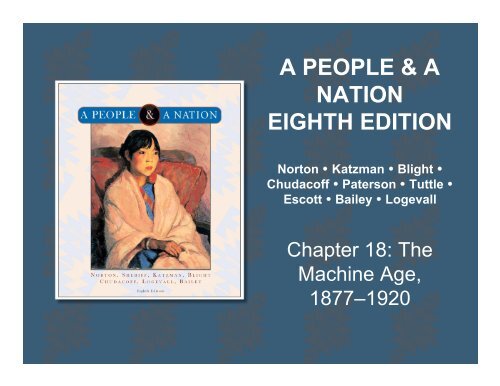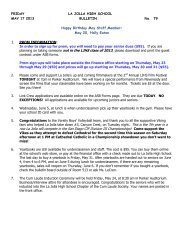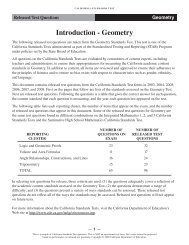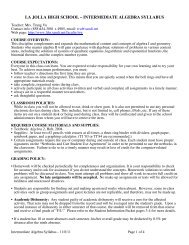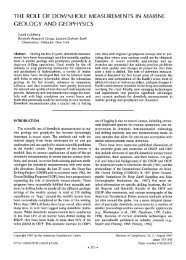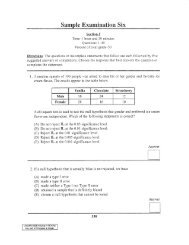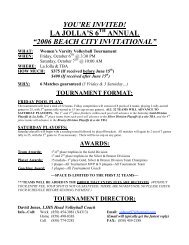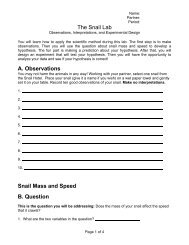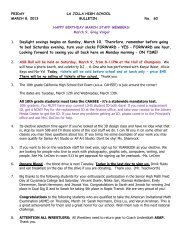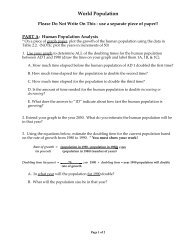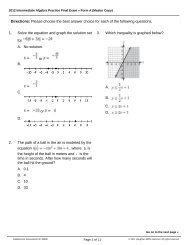Chapter 18
Chapter 18
Chapter 18
You also want an ePaper? Increase the reach of your titles
YUMPU automatically turns print PDFs into web optimized ePapers that Google loves.
A PEOPLE & A<br />
NATION<br />
EIGHTH EDITION<br />
Norton • Katzman • Blight •<br />
Chudacoff • Paterson • Tuttle •<br />
Escott • Bailey • Logevall<br />
<strong>Chapter</strong> <strong>18</strong>: The<br />
Machine Age,<br />
<strong>18</strong>77–1920
Ch.<strong>18</strong>: The Machine Age, <strong>18</strong>77–1920<br />
• Industrialization (mass production by<br />
machines) dramatically alter USA<br />
• USA shift from debtor, agricultural nation to<br />
industrial, financial, & exporting power<br />
• Start early <strong>18</strong>00s; accelerate late <strong>18</strong>00s<br />
• Workers: from producers of whole product, to<br />
employees who repeat specialized, timed tasks<br />
• New jobs, goods, & powerful national<br />
corporations<br />
• Negative aspects: uneven distribution of power<br />
Copyright © Houghton Mifflin Company. All rights reserved. <strong>18</strong> | 2
I. Birth of the Electrical Industry<br />
• Edison represent spirit of invention and<br />
effective marketing of new products<br />
• Generate electricity (Edison Electric Light Co.,<br />
<strong>18</strong>78) to transmit light, sound, images<br />
• Westinghouse’s generators & transformers<br />
send electricity long distances cheaply<br />
• Financiers (Morgan) merge companies into<br />
General Electric Co.<br />
• Individual inventors continue (G. Woods)<br />
Copyright © Houghton Mifflin Company. All rights reserved. <strong>18</strong> | 3
II. Henry Ford and the Automobile<br />
Industry<br />
• Visionary manufacturer esp. with organization<br />
• Ford Motor Co. (1903) produce 1000s of<br />
identical cars (Model T, 1908)<br />
• Assembly lines with specialized workers/<br />
machines<br />
• Automobiles spur related industries (oil, rubber)<br />
• Ford introduce Five-Dollar-Day plan (1914)<br />
• Head off unionization and help workers<br />
become consumers (from $2-day)<br />
Copyright © Houghton Mifflin Company. All rights reserved. <strong>18</strong> | 4
III. Chemical Industry; Southern<br />
Industry<br />
• Du Ponts fund first research lab (1911) to<br />
create consumer products (film, plastics)<br />
• Du Ponts (like Edison & Ford) harness<br />
innovation with organization for profit<br />
• Southern industry use 2 main southern<br />
crops<br />
• Duke’s American Tobacco Co.<br />
popularize machine-rolled cigarettes<br />
• Entice consumers with free samples &<br />
advertising<br />
Copyright © Houghton Mifflin Company. All rights reserved. <strong>18</strong> | 5
IV. Southern Textile Mills<br />
• Textile mills move from North to South<br />
• Electricity replace water to power mills<br />
• Southern labor cheaper because fewer<br />
unions and greater use of women &<br />
children<br />
• Some iron & steel factories in South<br />
• Some southerners (Grady) proclaim<br />
emergence of “New South” of<br />
industry/business/cities<br />
Copyright © Houghton Mifflin Company. All rights reserved. <strong>18</strong> | 6
V. Consequences of Technology<br />
• Timing vary from industry to industry, but<br />
overall dramatic change develop<br />
• Telephones & typewriters revolutionize<br />
communications (not need face-to-face)<br />
• Higher production at lower cost create<br />
profits<br />
• Only large companies can afford<br />
specialized machines & bulk raw<br />
materials<br />
Copyright © Houghton Mifflin Company. All rights reserved. <strong>18</strong> | 7
VI. Frederick W. Taylor and<br />
Efficiency<br />
• Nature of work change as new managers take<br />
control over how product made<br />
• Stress efficiency (faster production with fewer<br />
skilled workers) to cut costs & boost profits<br />
• Convert worker:<br />
• From skilled producer (control labor) to<br />
unskilled employee (interchangeable part on<br />
assembly-line)<br />
• Watertown molders vs. Merrick’s stopwatch<br />
Copyright © Houghton Mifflin Company. All rights reserved. <strong>18</strong> | 8
VII. Mechanization and the<br />
Changing Status of Labor<br />
• Mass production divide manufacturing<br />
into small tasks<br />
• Worker repeat specific task<br />
• Fewer workers produce more in less time<br />
• Workers resist loss of control over when<br />
to work, how to make product, pace of<br />
work<br />
• Employers gain control of workplace and<br />
try to control workers at home<br />
(temperance)<br />
Copyright © Houghton Mifflin Company. All rights reserved. <strong>18</strong> | 9
VIII. Restructuring the Work Force:<br />
Women<br />
• Employers cut labor costs by hiring women<br />
for menial jobs in textiles, food-processing<br />
• Proportion of women in domestic service<br />
drop<br />
• # in clerical jobs skyrocket (Figure <strong>18</strong>.1)<br />
• <strong>18</strong>80: 2.6 million female employees<br />
• 1900: 8.6 million female employees<br />
• Pervasive sex discrimination (lower wages<br />
than men, few opportunities for promotion)<br />
Copyright © Houghton Mifflin Company. All rights reserved. <strong>18</strong> | 10
IX. Restructuring the Work Force:<br />
Child Labor<br />
• Employers (esp. shoes, textiles) cut costs<br />
by hiring children for fraction of adult wage<br />
• Figure <strong>18</strong>.2: percentage of child workers<br />
• Many more work street trades<br />
• A few states pass laws to regulate child<br />
labor<br />
• Big companies (interstate commerce) evade<br />
laws<br />
• Families need child’s income to survive<br />
Copyright © Houghton Mifflin Company. All rights reserved. <strong>18</strong> | 11
X. Industrial Accidents; Freedom of<br />
Contract<br />
• Numerous accidents push families into<br />
poverty<br />
• Employers evade responsibility<br />
• In 1913: 25,000 killed, 1 million maimed<br />
• Triangle Shirtwaist Co. fire (1911) kill 146<br />
• Employers theorize workers can seek<br />
higher wages elsewhere if unhappy<br />
• Reality: difficult to find steady job<br />
• So employers can pay low wages and<br />
fire workers who call for better<br />
pay/conditions<br />
Copyright © Houghton Mifflin Company. All rights reserved. <strong>18</strong> | 12
XI. Court Rulings on Labor Reform<br />
• Courts help employers by denying<br />
workers right to organize and bargain<br />
collectively<br />
• Supreme Court void most laws to<br />
regulate workplace/hours<br />
• Claim workers = free individuals (Lochner<br />
v. NY, 1905)<br />
• Muller v. Oregon (1908) allow regulation<br />
of female workers to safeguard health<br />
• End up barring women from many jobs<br />
Copyright © Houghton Mifflin Company. All rights reserved. <strong>18</strong> | 13
XII. Railroad Strike of <strong>18</strong>77<br />
• Some workers unionize to resist<br />
workplace changes<br />
• B/c of wage cuts & increased workloads,<br />
unionized rail workers strike across USA<br />
• Some turn violent<br />
• Employers crush strike with violence<br />
(state militias) & strikebreakers<br />
• President Hayes send in US troops = 1st<br />
significant use of army to quell labor<br />
unrest<br />
Copyright © Houghton Mifflin Company. All rights reserved. <strong>18</strong> | 14
XIII. Knights of Labor<br />
• Most early unions = “trade/craft” unions<br />
• Restrict membership to skilled workers in<br />
particular craft<br />
• Result = small membership<br />
• Knights = 1 st major broad-based labor<br />
union<br />
• Start <strong>18</strong>69; under Powderly, 730,000 by<br />
<strong>18</strong>86<br />
• Knights admit unskilled workers, women,<br />
African Americans, & recent immigrants<br />
Copyright © Houghton Mifflin Company. All rights reserved. <strong>18</strong> | 15
XIII. Knights of Labor (cont.)<br />
• Seek alternative to profit-oriented<br />
industrial capitalism<br />
• Offer vision of workers owning &<br />
operating factories via cooperatives<br />
• Vision attractive, but often vague<br />
• Powderly also oppose strikes<br />
• Over time skilled members desert<br />
Knights to form craft unions & pursue selfinterest<br />
Copyright © Houghton Mifflin Company. All rights reserved. <strong>18</strong> | 16
XIV. Haymarket Riot (<strong>18</strong>86)<br />
• Many Chicago workers protest in support of<br />
8-hour workday<br />
• A few anarchists join<br />
• In response to largest spontaneous labor<br />
demonstrations, Chicago crush strikes with<br />
force<br />
• Workers respond with further protests<br />
• After bomb, Chicago (fearing radicalism &<br />
unrest) arrest many anarchists & unionists<br />
• Cities also strengthen police<br />
Copyright © Houghton Mifflin Company. All rights reserved. <strong>18</strong> | 17
XV. American Federation of Labor<br />
• An alliance of craft unions, AFL emerge as<br />
major labor organization by late <strong>18</strong>80s<br />
• Gompers focus on concrete goals (better pay,<br />
conditions) for skilled workers<br />
• Exclude recent immigrants & blacks because of<br />
competition for jobs, pay fears, & prejudice<br />
• When strikebreakers, immigrants & blacks<br />
reinforce bias of native skilled workers<br />
• Only Knights & IWW admit immigrants, blacks<br />
Copyright © Houghton Mifflin Company. All rights reserved. <strong>18</strong> | <strong>18</strong>
XVI. Homestead Strike; Pullman<br />
Strike<br />
• Continued violence hurt union movement<br />
• Pay cuts prompt Homestead Steel Strike,<br />
<strong>18</strong>92<br />
• Workers resist exploitation at Pullman,<br />
<strong>18</strong>94<br />
• In both, armed force defeat strikers<br />
• Violence by labor offend public opinion<br />
Copyright © Houghton Mifflin Company. All rights reserved. <strong>18</strong> | 19
XVII. Industrial Workers of the<br />
World (IWW)<br />
• Western miners form it (1905)<br />
• Welcome unskilled workers like Knights<br />
• A radical union<br />
• Accept violence/class conflict<br />
• Advocate socialism<br />
• Hold protests across USA<br />
• Membership small<br />
• Hurt by government persecution<br />
Copyright © Houghton Mifflin Company. All rights reserved. <strong>18</strong> | 20
XVIII. Women Unionists<br />
• Most craft unions (AFL) exclude women<br />
• Reflect traditional views on gender and<br />
competition for jobs, pay fears<br />
• Women form separate unions<br />
• Men dominate national labor leadership<br />
• Telephone Operators = femaledominated<br />
union<br />
• Women’s Trade Union League (1903)<br />
lobby for laws to help working women<br />
Copyright © Houghton Mifflin Company. All rights reserved. <strong>18</strong> | 21
XIX. The Experience of Wage Work<br />
• Majority of workers not join unions<br />
• 1900: only 1 million of 27.6 million<br />
workers<br />
• Getting & holding job = priority for most<br />
• Intense competition for jobs<br />
• Seasonal nature of work with layoffs<br />
• Some form fraternal societies for help<br />
• To most workers, machine age = mixed<br />
results<br />
Copyright © Houghton Mifflin Company. All rights reserved. <strong>18</strong> | 22
XX. Standards of Living;<br />
Commonplace Luxuries<br />
• Consumer-oriented society develop<br />
• Ready-made clothing, canned food, & home<br />
appliances change dress, diet, habits<br />
• New industrial elite emerge<br />
• 1920: richest 5% earn 25% of earned<br />
income<br />
• Size & income of middle class expand<br />
• Wages for most workers increase<br />
• But seasonal nature of work weaken<br />
earnings<br />
Copyright © Houghton Mifflin Company. All rights reserved. <strong>18</strong> | 23
XXI. Cost of Living;<br />
Higher Life Expectancy<br />
• Cost of living rise faster than wages for<br />
most<br />
• Many workers afford new goods only by<br />
having wives & children work for pay<br />
• Also rent rooms to boarders<br />
• Extensive wage/money economy develop<br />
• Post-1900, science & technology<br />
increase life expectancy & lower death<br />
rate from disease<br />
• More young attend school; path to middle<br />
class<br />
Copyright © Houghton Mifflin Company. All rights reserved. <strong>18</strong> | 24
XXII. Flush Toilets and Other<br />
Innovations<br />
• Symbolic of revolution in lifestyle<br />
• Mass production (post-1900) change<br />
habits/ attitudes toward cleanliness,<br />
water use<br />
• First for elite and middle class<br />
• Spread to working class, post-1920<br />
• Tin cans, refrigerated rail cars, iceboxes,<br />
& dietary reform (Kellogg) diversify diets<br />
• Workers still spend much of their pay on<br />
food<br />
Copyright © Houghton Mifflin Company. All rights reserved. <strong>18</strong> | 25
XXIII. Ready-made Clothing;<br />
Department Stores<br />
• By 1900, clothing shift from being made at<br />
home to mass-produced, consumer product<br />
• Department stores create merchandising<br />
revolution (big stores with massive<br />
inventory)<br />
• A&P, Woolworth’s = 1st national chain<br />
stores<br />
• Advertising (newspapers, billboards) entice<br />
Americans to consume new products<br />
• Try to create brand loyalties<br />
Copyright © Houghton Mifflin Company. All rights reserved. <strong>18</strong> | 26
XXIV. The Corporate Consolidation<br />
Movement<br />
• Recurring boom/bust cycles hit economy<br />
• Business leaders use centralization for<br />
stability<br />
• Use corporations to raise capital with limited<br />
liability (help from Supreme Court)<br />
• Massive conglomerates dominate economy<br />
• Start with pools, then trusts<br />
• Later holding companies & mergers<br />
• Ruthlessly take control of small competitors<br />
Copyright © Houghton Mifflin Company. All rights reserved. <strong>18</strong> | 27
XXIV. Consolidation Movement<br />
(cont.)<br />
• With horizontal & vertical integration,<br />
JDR’s Standard Oil refine 84% of US oil<br />
by <strong>18</strong>98<br />
• Financiers (Morgan) assume new power<br />
• Corporate growth expand stock/bond<br />
exchanges, foreign investment, personal<br />
savings, & bank investments<br />
• Industrial leaders assert Social Darwinism<br />
• Also demand government aid (tariffs,<br />
loans)<br />
Copyright © Houghton Mifflin Company. All rights reserved. <strong>18</strong> | 28
XXV. Carnegie’s Gospel of Wealth<br />
and Its Critics<br />
• Justify his wealth/power with philanthropy<br />
• Critics argue greedy monopolies exploit<br />
workers, stifle competition, & corrupt<br />
politics<br />
• Criticize Social Darwinism & laissez-faire<br />
• George & Bellamy advocate using<br />
government to solve mass poverty<br />
• Sherman Anti-Trust Act (<strong>18</strong>90) example<br />
of early big business regulation<br />
• Unsuccessful (US v. EC Knight Co, <strong>18</strong>95)<br />
Copyright © Houghton Mifflin Company. All rights reserved. <strong>18</strong> | 29
Summary: Discuss Links to the<br />
World & Legacy<br />
• Atlantic Cable as multinational effort?<br />
• Cable reflect & increase US-British links<br />
• Increased global communication by 1902?<br />
• How recorded sound a key legacy of late-<br />
<strong>18</strong>00s industrialization?<br />
• Innovation of technology & chemistry?<br />
• Role of competition between Edison & Bell?<br />
• Shift popular music from playing to listening?<br />
Copyright © Houghton Mifflin Company. All rights reserved. <strong>18</strong> | 30


